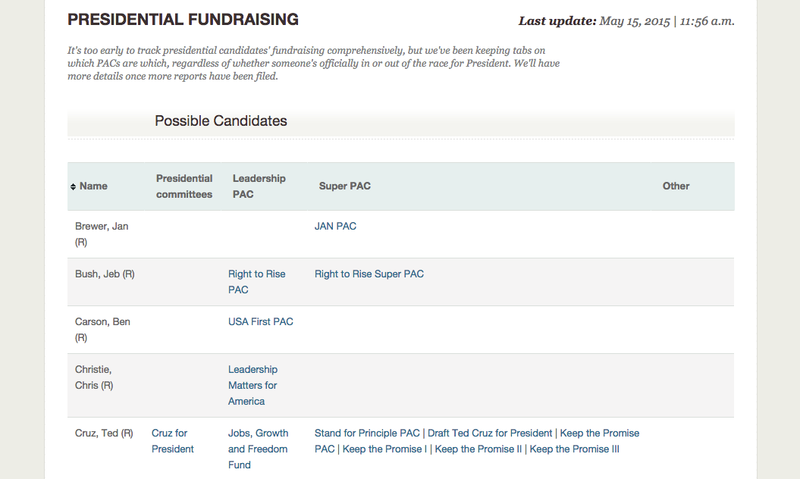Introducing Sunlight’s presidential committee tracker

Pursuing America’s Greatness? Fund for America’s Future? Leadership Matters? Trying to keep track of the ever-growing list of presidential super PACs can be like trying to catch water with a net.
To help White House watchers tracking the millions of dollars at play in next year’s election, Sunlight’s Real-Time Federal Campaign Finance tracker has added a new collection of political committees supporting known, and likely, presidential candidates.
The new page groups all the campaign vehicles of the major contenders in one place, with links to summaries of the groups’ latest financial activity.
We have a fairly comprehensive list of likely candidates and their associated political organizations, but it’s an imprecise practice: There is no official list of candidates that might run for president next year, so our list is mostly populated by manual research. If you think we have missed someone, or a certain committee, please let us know.
Many candidates are already raising and spending money like a presidential contender.
Some candidates’ leadership PACs — the type of committee politicians use to raise money for other candidates — have already switched into campaign mode. RAND PAC, the leadership arm of Sen. Rand Paul, R-Ky., spent more than $50,000 on a variety of political consultants just weeks after the 2014 midterms concluded. Generally, leadership PACs are used to share campaign funds with political allies.

Similarly, Right to Rise PAC, which is affiliated with former Florida Gov. Jeb Bush, has already dished out $10,000 donations to Republican parties in Iowa and New Hampshire, according to recent reports from the party committees.
Those figures are a pittance, however, compared to the money we’ll see begin to pour out of super PACs beginning in the next few months.
The majority of super PACs — committees that can raise and spend unlimited amounts on campaigns — on our list were recently created. Currently, the only information we have about their finances is what has been reported in the media. That will change on July 31, when most of the super PACs will make their first public disclosures of the money they raised and spent to the Federal Election Commission. That’s when we will find out who has been writing the checks for the reported $100 million to be raised by the Jeb Bush allies running his super PACs and the unknown millions that will pulled be pulled in by Ready for Hillary.
Though we link these free-spending super committees with the candidate they are likely to support, it’s important to note that, legally, a super PAC may not coordinate any of its spending or campaign strategy with a federal candidate.
To provide as complete a picture as possible of the presidential landscape, we have also included political entities that don’t register at the FEC. To get technical: These include political groups organized under section 527 of the Internal Revenue Code, which make financial disclosures to the IRS, and 501(c)4 nonprofit organizations, often called dark money groups because they are not required to reveal their donors.
The goal is to provide the public with as complete a picture as possible of a candidate’s financials, but, since super PACs and 527 committees aren’t technically “affiliated” with the candidates they support, there is no universal super PAC list. So, if you think we have missed a committee, or see a potential candidate you think we should include, please let us know!

